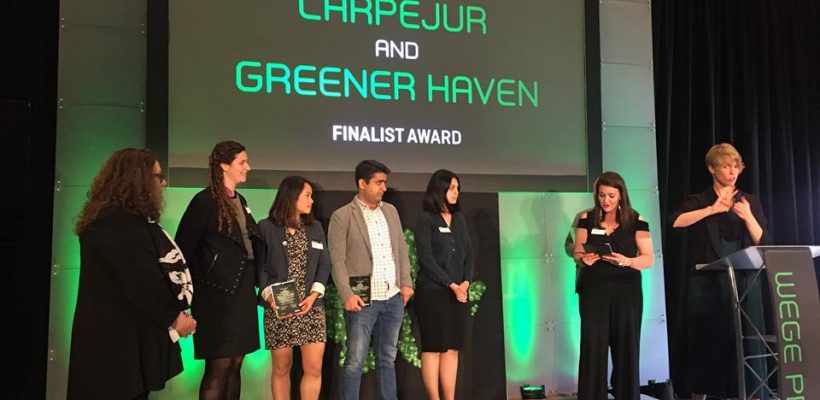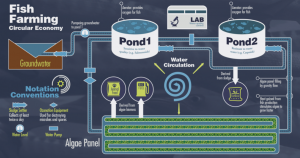
Three AUA Students Among Finalists of Wege Prize 2018
3 min readGRAND RAPIDS, USA ‒ On May 18, 2018, the CarpeJur team, where three out of the five members are from the American University of Armenia (AUA), was among the five finalists of the Wege Prize 2018 competition, coming away with a $1,000 prize during the Finalist Awards. The teams presented their products, services, business ideas, and other groundbreaking solutions to world economic problems to expert judges at Kendall College of Art and Design (KCAD) of Ferris State University, Grand Rapids, Michigan.
The Wege Prize is an annual international student competition which gives the participants the opportunity to collaborate across institutional, disciplinary, and cultural boundaries, and use design thinking principles to reshape the way world economies work. This year, 17 interdisciplinary teams of five undergraduate and graduate students came up with projects that promote the transition from a linear economic model to a circular one. As an alternative to a traditional linear economy, a circular economy seeks to maintain natural resources at their highest utility by recovering and re-adapting them after each cycle.
 CarpeJur is designed as a closed-loop aquaculture system which aims to increase water efficiency by recirculating fish farm wastewater with the help of algae, which act as biofilters to clean the water and to use it again. In addition, the system allows upcycling natural by-products by extracting oil from the algae to produce biodiesel and by getting animal feed from the algae and natural fertilizers from the “sludge.” The members of the team are AUA students Garo Bozadjian (CIS ’18), Sinara Gharibyan (MSE ’18), and Gor Hakobyan (BAB ’18) together with Natella Gharibyan from Yerevan State Medical University (YSMU) and Vachagan Darbinyan from Armenian National Agrarian University (ANAU). Another AUA student Levon Hovhannisyan (BAB ’20) helped the team to design their final report which was decisive for the results of the competition.
CarpeJur is designed as a closed-loop aquaculture system which aims to increase water efficiency by recirculating fish farm wastewater with the help of algae, which act as biofilters to clean the water and to use it again. In addition, the system allows upcycling natural by-products by extracting oil from the algae to produce biodiesel and by getting animal feed from the algae and natural fertilizers from the “sludge.” The members of the team are AUA students Garo Bozadjian (CIS ’18), Sinara Gharibyan (MSE ’18), and Gor Hakobyan (BAB ’18) together with Natella Gharibyan from Yerevan State Medical University (YSMU) and Vachagan Darbinyan from Armenian National Agrarian University (ANAU). Another AUA student Levon Hovhannisyan (BAB ’20) helped the team to design their final report which was decisive for the results of the competition.
“Through participation in the Wege Prize 2018 I have learned a lot about the circular economy, fish farming, the food different fish need to eat, how the algae grow and absorb all the toxic elements from the water and make it almost clean again, and some little things about chemistry. From the perspective of professional development, as a data scientist, I have learned how to gather data from ministries, preprocess and plot them to show how our idea will work with fish farms. Most importantly, I have learned how to work in a group,” Bozadjian said.
The AUA participants also highlighted the importance of the practical skills and knowledge on environmental topics gained during the Wege Prize competition. Gharibyan remarked that she would undoubtedly recommend others to participate in the competition as “firstly, it develops a new, more global way of thinking; then it is a great chance to present your ideas to an international audience and get their feedback; and finally, it is very honorable to represent your country and university in a good way.”
Three advisers helped the CarpeJur team to develop their project: Dr. Natella Mirzoyan, a Research Assistant Professor at AUA’s Acopian Center for the Environment (ACE), and an aquaculture expert at the International Center for Agribusiness Research and Education (ICARE), Vardan Hayrapetyan, an adjunct lecturer at ACE, and Lusine Tadevosyan, a Project Manager at Sustainable Fisheries for Enhanced Water Resources in Armenia (SFEWRA) project in ICARE foundation (under the USAID-funded PEER program). Dr. Mirzoyan and Hayrapetyan helped the team with the development of the circular economy model and other environmental issues.
“I suggested the current model, which is a result of my life-long experience in near-zero-discharge fish-farming, which is entirely based on circular economy. This kind of work is also done in ICARE for 15 small and medium sized fish farm, but for each farm different configurations/systems are used. As we needed economic calculations to be done, Lusine offered her help, and then it became a large team effort. It was a nice, intense process with lessons for all of the parties involved,” Dr Mirzoyan noted.
In the scope of the SFEWRA project, the CarpeJur team had the opportunity to go through the prototyping of the system in an actual fish farm and grow algae. In addition, SFEWRA project researcher Narek Avetisyan put great effort into the CarpeJur project by helping the team to do relevant laboratory analysis and water quality testing in ICARE under the supervision of Dr. Mirzoyan and Tadevosyan. It is important to note that Tadevosyan also assisted CarpeJur in gathering all the information needed for economic and financial feasibility calculations, in particular costs of producing fish, initial investments, the fish production rate and price. Furthermore, she provided the team with periodic consultancy on calculation of the project’s economic feasibility.
Founded in 1991, the American University of Armenia (AUA) is a private, independent university located in Yerevan, Armenia, and affiliated with the University of California. AUA provides a global education in Armenia and the region, offering high-quality graduate and undergraduate studies, encouraging civic engagement, and promoting public service and democratic values.
